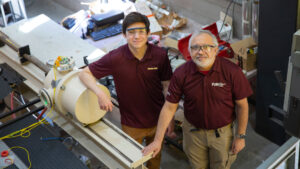Jake Henry Trenter
Aerospace engineering
Hometown: Scottsdale, Arizona, United States
Graduation date: Spring 2023

FURI | Spring 2022
Optimization of Compression Cell Geometry to Maximize Pressure Generation in Elastomers During Total Scattering Experiments via Finite Elements
Polyurea is an elastomer that has shown unique properties under large compressive stresses indicating that it may be a promising armor coating material. High-pressure testing at a synchrotron will utilize x-ray scattering to observe how the polyurea responds to large compressive stresses at the atomic level. For these tests, a high-pressure cell containing the sample must be designed with optimal geometries. This research project uses Ansys software to create multiple finite element analysis simulations to determine the optimal geometries for the aluminum gasket, diamond anvils, and the sample all within the high-pressure cell.
Mentor: Pedro Peralta
Featured project | Spring 2022
Aerospace engineering junior Jake Trenter is studying how polyurea, an elastic and viscous polymer, reacts under compressive stress to see if it could be used as an armor coating. As a FURI student working with Professor Pedro Peralta, Trenter is learning about all the details that go into engineering research.
What made you want to get involved in FURI?
I wanted to work on an engineering project outside of class, and the different engineering research projects that professors at ASU were working on got me interested in FURI.
Why did you choose the project you’re working on?
I chose to work with Dr. Peralta on a research project involving polyurea because of the many applications that an armor coating material can have to improve the design integrity for anything from aerospace applications to defense and more.
How will your research project impact the world?
Developing polyurea into an armor coating that can protect a system in an environment where shock loading (when a sudden force is applied) may be present can not only improve countless applications but can also save lives. As an aerospace engineering major, one of the potential applications I’ve thought about is utilizing this coating to protect manned spacecraft against space debris in orbit. Upon impact from a projectile in space, if the polyurea armor coating could prevent breakthrough — a situation where depressurization is likely — only deformation would occur, saving lives.
What has been your most memorable experience as a student researcher in FURI?
My most memorable experience as s student researcher is speaking with Dr. Peralta and Tyler Eastmond, a doctoral student in Dr. Peralta’s research group, about all the intricate steps involved to use x-ray scattering to view how the polyurea is responding to stress at the atomic level. These conversations made me realize the complexity and level of detail that goes into acquiring this material data, and I found it to be quite fascinating.
How do you see this experience helping with your career goals?
I believe that the engineering design experience I’m acquiring from working on this project will allow me to showcase some of the work I am doing outside of class. I think this will help with job applications, and it will help me if I decide to pursue an advanced degree after my undergraduate education as well.
Why should other students get involved in FURI?
The FURI program is a great way for students to acquire some real-world engineering design experience outside of class while earning their degree. It’s a great way to build your resume and expose yourself to the research and development side of engineering.




